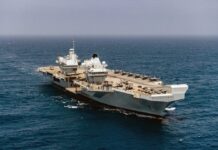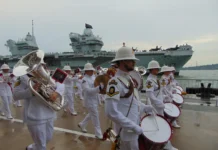
Dictionary of Royal Fleet Auxiliary Ships from 1905. By Thomas A Adams MBE. Whittles Publishing, Dunbeath, Caithness, 2025. ISBN 978-184995-575-1
Reviewed by David Hobbs
Thomas Adams is a retired journalist and shipping historian who is historical consultant to the RFA Association and author of numerous published articles. This is his first book and it clearly represents the culmination of many years research.
The forward by Commodore David Eagles, who was Commodore of the RFA from 2020 to 2024, makes the point that this is the first complete listing of every RFA vessel to be published for over fifty years. He goes on to thank the author for the effort that he put into compiling this book which he describes, with some justification, as being the definitive work on the subject.
The RFA has existed since 1905 but in many respects the organisation we know today as a fully-integrated element of the Royal Navy has its origins in the fleet train that supported the British Pacific Fleet during its extended periods at sea off Japan during 1945 and during the long-running RN and RAN carrier operations during the Korean War. As a student of both conflicts I found this book to contain a wealth of detail about the wide range of auxiliaries and their capacity to replenish warships at sea. The first 16 pages contain a brief history of the RFA, its evolution in peace and war together with the composition and roles of the organisation today. These include constabulary operations with Fleet Air Arm helicopters and Royal Marines embarked, amphibious warfare deployments, presence missions in support of Commonwealth nations and many other tasks beyond providing afloat logistic support for global British and allied task forces.
The bulk of the text, just over 390 pages is laid out as an A to Z dictionary listing every RFA vessel by name in its due alphabetical order. Where these ships formed part of a class or group, for instance with the Wave class tankers which served from 1944 onwards, there is a separate and more detailed description of the whole class including their design, specification and employment. Small photographs and drawings illustrate many, but not all, of the ships and these are sufficient to give the reader an impression of their appearance in service. Many of the ships served in the Indian and Pacific Oceans and had names that will be familiar to RAN veterans but some of the ships listed served with the RAN as well as the RFA. These include the former tanker Appleleaf which became HMAS Westralia in 1994; the landing ship (dock) Largs bay which became HMAS Choules in 2011; RFA Bishopdale which was partially manned by RANR defensive gunners in 1944; RFA Kurumba run by an Australian ship’s company after 1922; HMAS Tobruk, a landing ship built to the same design as the RFA ‘Sir’ class logistic landing ships which joined the RAN in 1978 and HMAS Supply, the former RFA Tide class tanker Tide Austral which was transferred to the RAN in 1962.
Ships’ names begin with the freighting tanker Abadol on page 1 and end with William Scoresby on page 389. Two multi-role support RFAs purchased in 2023 must have been added after the main text had been paginated and prepared for printing but they have been included as Appendix one. A second appendix covers ships that are frequently described as RFAs but which were not and a third gives a historical overview of the ‘Leaf’ group tankers. An index would have made it quicker to find individual ships than leafing through a number of pages looking for them but the layout by individual ship and class names does have the merit that every ship has an entry and a focus on its own history and features. On the other hand it does mean that the same descriptions and phrases are frequently repeated, adding considerably to the number of printed words.
It is only fair, however, to point out to potential readers that there are a number of typographical errors in the text. Some of these are minor but some could cause confusion, for example on page 290 there is a statement that Geen Rovercarried out a Harrier landing demonstration at Greenock in 1971 during an RN Equipment Exhibition but on page 162 the correct location, Greenwich, is given in the section on the Rover class. There is some confusion in a number of entries between avgas and avcat and between the NATO designations given to various fuels. On page 288 for example Avcat is described as F 76; it should be F 44 and furnace fuel oil is described as F 44 but should be described as F 77. These particular errors occur with sufficient frequency that I would advise readers to be wary of them and it would be a good idea to have a separate list of NATO fuel designations to hand. Others are obvious errors of transcription, for example on page 152 where it is stated that during HMS Queen Elizabeth’s 2021 Pacific deployment, Operation Fortis, 834 naval air squadron carried out 845 landings. The last 834 NAS de-commissioned in December 1944 and I am sure that what the author meant to say was that 845 NAS carried out 834 landings. Some errors are amusing such as the reference to ‘extensive carnage’ under the heading Cranes & Deck Gear on page 91.
Minor errors aside, Thomas Adams has written an important book that adds substance to the references about logistical re-supply at sea in a number of operational histories including the Second World War works by Hermon Gill and Roskill. For the first time in decades these important ships have been given the focus they deserve and there is a reference work that describes their loads and the equipment used to transfer both liquids and solids at sea as well as their pennant numbers, callsigns and communications fit. Twelve blank pages after the text give space for readers to add notes on future vessels as they join the fleet but I hope that there will be a second edition that will obviate the need for doing so. If there is, hopefully those niggling errors will be corrected.
Overall, however, I found this to be a good reference source that makes a valuable contribution to the historiography of naval operations over the past 120 years. I recommend it to ANI members as the best reference source currently available on RFA vessels.


